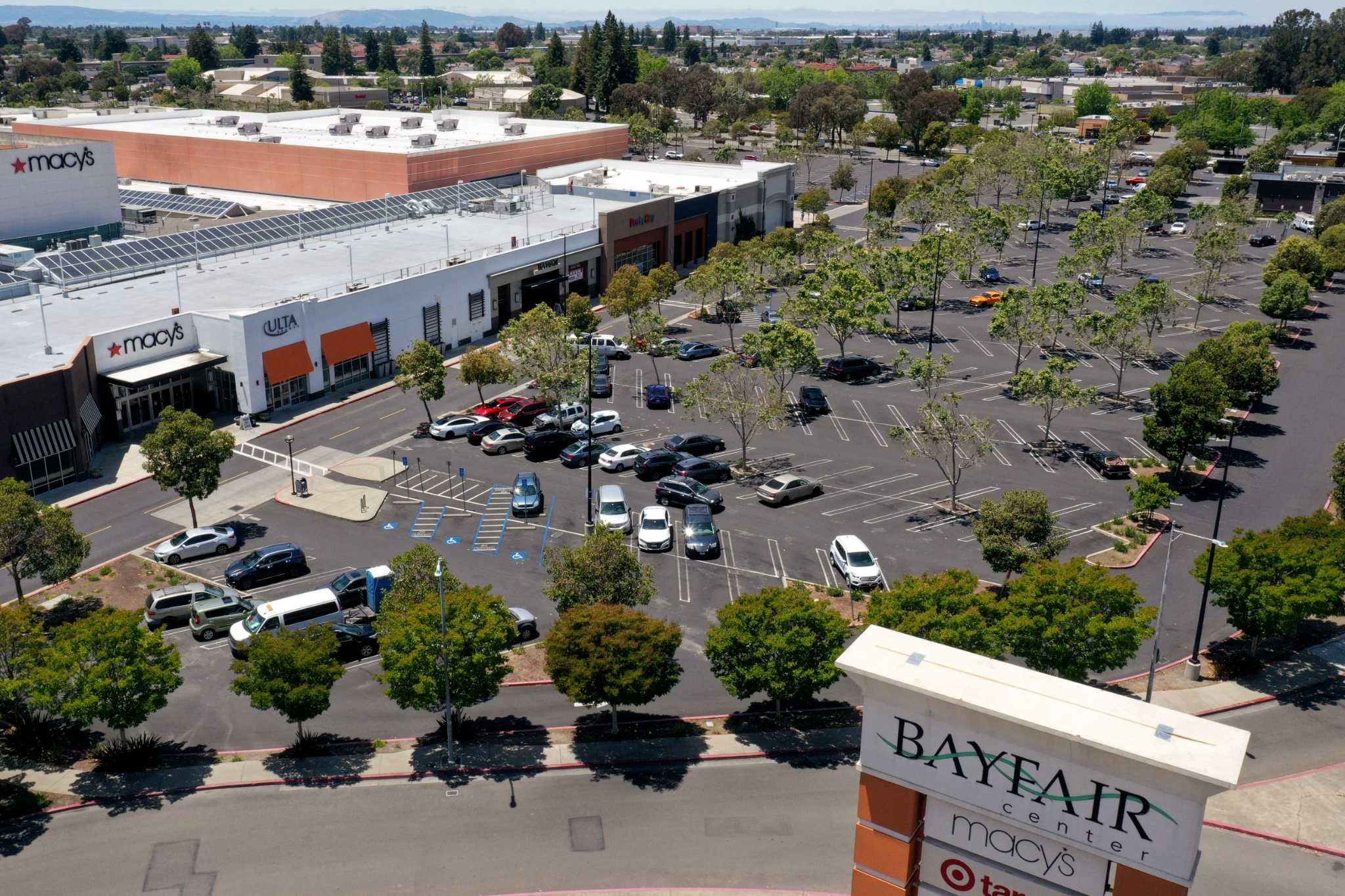What Bay Area malls could join S.F.’s Westfield in uncertain future?
This is a carousel. Use Next and Previous buttons to navigate
There’s high drama this month at Westfield San Francisco Centre, with its owners abandoning the huge downtown mall to their lenders while Nordstrom, its largest tenant, prepares to close this summer.
But similar dramas have played out for decades around the Bay Area, California and the nation.
That’s because the nature of shopping centers is that they never stop changing. Stores come and go. Owners do as well. Surrounding communities flourish and fade. As the years go on — and the vertical mall at Fifth and Market streets is relatively young by industry standards, having opened in 1988 with a 2006 expansion — each space becomes its own creation, no matter what the intent might have been at the start.
“It’s all evolutionary,” said J. Victor Fandel, a veteran Bay area commercial real estate broker. “A lot depends on the terrain and geography of the marketplace. Some become more important or less important, and some become very different places.”
You see this in three East Bay malls that reflect the trajectory of 21st Century retail centers across the region as a whole. One is robust. One is marked for extinction. The third functions pretty much as it always has, remarkable for how little it has changed.
The endangered
Santiago Mejia/The Chronicle
San Leandro’s Bayfair Center began life in 1957 as a standard suburban shopping center. A huge parking lot at East 14th St. offered access to a Macy’s, a supermarket and an outdoor commons where middle-class Americans could mingle and browse.
Now it’s a mall in limbo. And it’s not alone.
Roughly 185 malls have closed in the United States during the past 20 years, according to Green Street, a real estate analytics firm. This includes 74 since 2018. Bay Area centers have fared better, given the region’s prosperity, but Richmond’s Hilltop Mall closed in 2021, except for an attached Walmart that remains open.
More could follow: In Marin, a developer wants to replace San Rafael’s Northgate Mall with 1,345 housing units and a neighborhood shopping center. The longtime owner of Hillsdale Shopping Center in San Mateo envisions something similar. A medical research campus could join housing in a total makeover of San Bruno’s Shops at Tanforan, according to conceptual plans filed with the city last year.
Santiago Mejia/The Chronicle
A similar fate is likely in store for Bayfair, a mall whose long-term decline has only hastened since its 42-acre site was purchased last year by the B3 and Gaw Capital Partners.
Walk inside the mall and just three glassy retail spaces remain in business beneath the skylights with their peeling film intended to reduce glare. There’s also a kiosk that specializes in cell phone repairs that is a few feet away from tall plywood panels blocking off the rest of the interior storefronts.
To the right of the kiosk is Kohl’s, one of Bayfair’s remaining anchors. “As of February 2023 our mall entrance is closed,” reads a sign taped to one large glass door.
“We don’t know what comes next,” said the man staffing the phone repair kiosk, who declined to give his name. “There’s no one here.”
City of San Leandro
Bayfair was always out of step: it debuted the year after America’s first fully enclosed mall, Southdale Center near Minneapolis, which spawned a new breed of consumer compounds that Time magazine dubbed “Pleasure-Domes with Parking.”
When Bayfair expanded 20 years later it added a roof to make up for lost time. Weirdly, the expansion coincided with the completion of a BART station to the west — which could be reached only by walking past loading docks and crossing a narrow bridge over a concrete canal.
After the novelty faded, Bayfair tried to lure shoppers with stores that ignored the interior and opened only onto the parking lot. The major newcomers included Staples, Target and Bed Bath & Beyond. Just Target remains, with a security vehicle made up to resemble a police car parked outside.
Though the team of B3 and Gaw has yet to announce its plans for Bayfair, the city of San Leandro is in line to receive a $1.8 million grant by the Metropolitan Transportation Commission to map out how a mixed-use “transit village” could be fit onto the site. This would include improved connections to the BART station and, perhaps, keeping part of Bayfair’s shell but filling it with a research and development lab, or office space.
“Right now, you have a shopping center that happens to be next to BART. We want to treat transit as an asset,” said Avalon Schultz, San Leandro’s assistant community development director. “We’re really excited by the chance to create a place that becomes a catalyst, but also where existing (city) residents feel comfortable.”
Doing this might sound simple — what’s so hard about redeveloping a parking lot and a crate-like structure? Plenty, say experts.
“Property ownership gets really complicated,” said Ellen Dunham-Jones, a professor at the School of Architecture at the Georgia Institute of Technology who has written two books on retrofitting suburbia. One example: anchor stores frequently have 99-year leases — not just on their structure, but on a portion of the parking lot.
That’s why transformation often is a piecemeal thing, Dunham said, rather than a grand rebirth: “A lot of these projects really do happen incrementally.”
Schultz is confident that Bayfair’s next chapter will come sooner rather than later.
“As tenants go vacant,” she suggested, “what looks like a calamity could be viewed in another way, as new opportunities.”
The powerhouse
Santiago Mejia/The Chronicle
Broadway Plaza in Walnut Creek is the antithesis of Bayfair Center. It’s also part of the reason why San Francisco’s Union Square is reeling.
Colorful flowers spill from tall sidewalk planters. There’s a small plaza with cafe seating below a giant video screen. The spot that held a California Pizza Kitchen now is a free-standing Apple store, all four rounded sides in pristine glass. One storefront holds a Tesla dealership, not far from an Eileen Fisher boutique and across the way from Allbird’s.
Things were much different when Broadway’s original incarnation opened in 1951 with a Lucky’s and J.C. Penney as the main attractions. The growth that followed came in methodical waves, including the first Bay Area Nordstrom in 1984 and culminating in a substantial 2016 rebuild that included a floor of what now is coworking space above a landscaped pedestrian alley featuring mall staples from Wetzel’s Pretzels to Tommy Bahama.
Macerich, the Santa Monica-based owner, today describes Broadway Plaza as a “regional town center” with sales of more than $1,800 per square foot. Another way to look at it is as a variation of the Village at Corte Madera and Stanford Shopping Center — all three offer serious Bay Area shoppers the type of retail mix that once could only be found in San Francisco, but with free parking and a manicured ambiance.
City of Walnut Creek
Each reflects its community: That’s why Stanford’s retail line-up, drawn by the wealth of Silicon Valley, includes a Cartier and Hermès flanking a Neiman Marcus. In Corte Madera, three retail spaces in the long stroll from Macy’s to Nordstrom are devoted to electric vehicle makers, no doubt with an eye to generating buzz in one of the first counties where Tesla turned heads on local roads.
Broadway Plaza, though, is part of a traditional downtown.
That’s by fluke as much as anything — Broadway opened before Northland Center offered the self-contained template that retail developers soon embraced. One of the two public streets through it has been replaced with open-air retail, but the center remains inseparable from Walnut Creek’s increasingly prosperous core.
Put another way, there’s a Tiffany’s across the street to the west and a Restoration Hardware to the north.
Santiago Mejia/The Chronicle
The ambiance can feel precious. Nor is it problem-free: looters and vandals swarmed Nordstrom just as it was about to close one Saturday evening in 2021, assaulting workers and running out with bags of merchandise less than five minutes later. They then piled into waiting cars and sped off.
But occasional incidents aren’t the same as long-held outside perception in other parts of the Bay Area that Union Square is too much of a hassle to get to, and too fraught once you’re there. Broadway Plaza offers well-heeled shoppers a hint of urbanity — and blue skies above your head.
The outlier
Santiago Mejia/The Chronicle
When Sunvalley mall opened in 1967 on 72 acres of former corn and onion fields in Concord, it typified large ambitious malls of the era. This included two stories of shops in between three anchor department stores: Macy’s, J.C. Penney and Sears.
Remarkably, 64 years later, all three remain — even Sears, which once was America’s largest retailer but now has fewer than two dozen outposts.
“Wait, a Sear’s that is still open?,” asked Alexandra Lange, author of the 2022 book “Meet Me by the Fountain: An Inside History of the Mall.” “That’s something I didn’t expect.”
The central atrium is larger than in the early days, including a glass elevator beneath a gridded skylight. The skating rink is long gone, as is the 1,500-seat movie theatre.
But the real change can be seen in terms of the regulars — many of them teenagers, then as now — who visit Sunvalley to check out the merchandise, or each other.
Concord had a population in the 1960s that was roughly 85% percent white. The 2020 census orshows a place that’s much more diverse, 30% Latino and 13% Asian. If today’s Sunvalley includes such mall fixtures as Mrs. Field’s and Cinnabon there’s also Xpresion Cultural, a small Bay Area chain specializing in Latin American arts and crafts and apparel.
There are vacancies in the mall, but no hint of incipient blight. What you notice instead are such youth-oriented mainstream perennials as Uniqlo, Forever 21 and Abercrombie & Fitch — all of which have vacated San Francisco’s Market Street and Union Square in recent years.
The Bay Area has other malls that continue to function at a mass-market level, like Southland Mall in Hayward and Serramonte Center in Daly City. None, though, has the Sunvalley’s resilient timelessness.
“It’s pretty unusual to have something so middle-class that’s still humming along,” Lange said after hearing a description of the mall and its tenants. “It sounds like the mall I grew up with in North Carolina — a place where teens would walk around and their parents would shop for the family.”
Fandel had the same observation.
“It’s the rare mall that hasn’t had to redefine itself,” he suggested. “The ethnicities have changed, but it serves the community.”
This article has been updated to correctly identify the nation's first enclosed mall.
Source: San Francisco Chronicle


